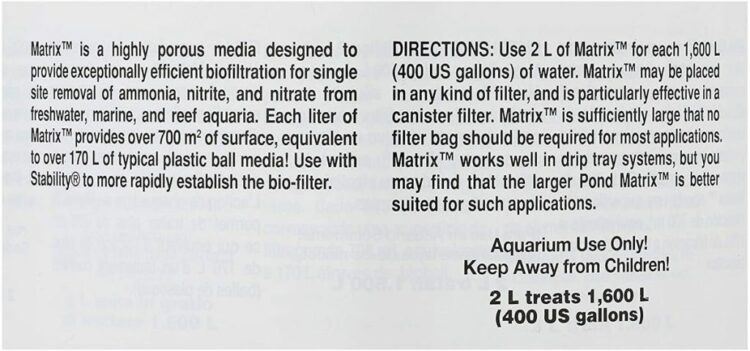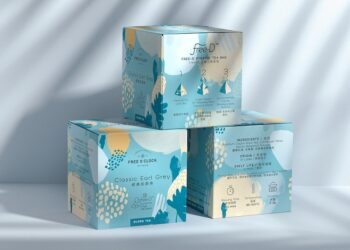Seachem Matrix
Bio media is the most important part of our aquarium filtration system, so it is important that we choose the best bio media for the job.
Bio media is where the vast majority of the bacteria that keep our aquariums clean and healthy live. This bacteria converts ammonia to nitrite, then another bacteria convert nitrite to less toxic nitrate.
Nitrate isn’t very toxic, but it does build up in the aquarium and can become dangerous to our fish in high quantities. So, to keep it low we change the water out in our aquariums to dilute it.
The effects of nitrate are often a little exaggerated and it doesn’t actually become too toxic until it is in the 100’s, but it is best kept as low as possible.
In order to convert nitrate to harmless Nitrogen, anaerobic (without oxygen) or anoxic (oxygen is only present within nitrite/nitrate molecules) conditions are required. This can be fairly difficult to achieve in the aquarium as we tend to keep our water well oxygenated to keep our fish healthy.
Water changes are the most effective method of keeping nitrates in check, but some media’ such as Seachem Matrix claim to help to reduce nitrate by providing anaerobic areas where the bacteria that consume nitrate can live.
This has some huge advantages. A reduction in nitrate in the aquarium can mean healthier fish and less maintenance. Win-Win.
Is Seachem Matrix a contender for the best bio media?
What is Seachem Matrix?
Seachem Matrix is a bio media made from natural, porous stone. On the surface, Seachem Matrix looks like any other pumice stone, but Seachem has specially selected this type for its porosity, pore size and inert nature.
It is said to have a massive surface area with pores that are ideally sized to support both aerobic and anaerobic bacteria (Aerobic at the edges and near the surface of the pores, anaerobic deeper inside the pores).
Here is Seachem’s description of Matrix:
Matrix™ is a high porosity bio media that provides efficient biofiltration for the removal of nitrogenous waste. Matrix™ is a porous inorganic solid about 10 mm in diameter. Each litre of Matrix™ provides as much surface (>~700 m2) as 170 litres of plastic balls! Plastic bio-materials provide only external surface area, whereas Matrix™ provides both external and internal macroporous surface area. These macropores are ideally sized for the support of nitrifying and denitrifying bacteria. This allows Matrix™, unlike other forms of bio media, to remove nitrate along with ammonia and nitrite, simultaneously and in the same filter.
Matrix™ is completely inert and will not break down. It need not be replaced. Since the majority of the bacteria are internal, Matrix™ may be rinsed when needed without damaging the filter. Matrix™ is compatible with all types of wet or wet-dry filters.
You can read more from Seachem themselves here.

How does Seachem Matrix work?
Seachem Matrix works like any other bio media. It provides surface area for bacteria to grow on in order to convert ammonia to nitrite and nitrite to nitrate.
It does this very well and I would put that down to its huge surface area.
But it claims to do something that many bio medias can’t – break down nitrate into harmless nitrogen.
As we’ve covered, Seachem Matrix is a porous stone. That means that there are small (tiny) holes in the stone where bacteria can live.
Because these holes are so small, within them there is less to no oxygen available. This means that anaerobic or anoxic conditions can be achieved within the pores. Anaerobic/anoxic bacteria are the types that convert nitrate into harmless nitrogen – denitrification.
Sounds great right? – It is if it works!
So, does Seachem Matrix work?
Denitrifying media
There are now a host of filter media’ that claim to be able to provide anaerobic conditions to reduce nitrate in the aquarium.
Many of these media’ have given mixed results and some have been found to be completely useless. There is a lot of debate on some of these media and one of the best examples is Biohome.
Biohome ultimate is a fairly expensive media that claims to be capable of reducing nitrates. It has become very popular amongst aquarists despite its high price point though and many of my fish keeping friends swear by it.
However, it was recently tested by Kev, at Kaveman Aquatics, who found that it did not do anything to his nitrate levels. Here is his video update:
However, it is important to note that Kev doesn’t fully explain his testing methods, he has also only used roughly 1.5kg (3.5lb) of Biohome. The recommended amount to show a reduction in nitrate on a heavily stocked aquarium is 1.5kg to 2kg per 100 litres.
This means that to show a noticeable effect, Kev would need roughly 10kg of Biohome ultimate for this 150 US gal (566 litre) aquarium. This would cost £150 and you would have trouble fitting it into your filtration.
There are however many tests on Youtube which claim that Biohome works perfectly. Unfortunately, I have yet to find a test where the aquarium isn’t full of live plants – Live plants consume nitrate, making the test invalid.
Here is an example by Youtuber FishPie:
Maybe I will test Biohome myself in future, but for now – back to Seachem Matrix.
So, I had been using Seachem Matrix in my filter for a while but I had never properly measured what effect it had on my nitrate levels.
Time to test it!
Seachem Matrix tested on nitrate
Before I start, I’d like to point out that I am not a scientist, I am not a chemist or physicist or anything else, I am a fish keeper. I don’t have a fancy lab or any fancy equipment, just a fish tank and a water testing kit.
However, I do understand that testing this needs to have some controls to make it fair and accurate.
So, here is how I planned to test Seachem Matrix’ effect on nitrate levels:
I have had 1 litre of Seachem Matrix in my filter for quite a long time. I was not about to remove this as it is doing a great job and removing it could put my fish at risk of an ammonia or nitrite spike.
I began by taking several readings of my nitrate levels over a three week period whilst conducting my regular maintenance routine of 80% water changes per week, always on Friday.
I also ensured that I was feeding the same amount of food to my fish each day, measuring out a quantity of each type of pellet. I also employed the controls listed below to ensure that nothing else changed.
My aquarium showed its ‘usual’ nitrate levels. After a water change, nitrates showed below 5ppm (parts per million). By the end of the week, they were around 40ppm, showing a build-up to this throughout the week – pretty standard.
This is pretty normal for this tank since I first added Matrix. It is stocked with messy American Cichlids and this is the reason I conduct large weekly water changes – they make a lot of mess and nitrates climb pretty quickly.
I continued to monitor these levels for three weeks to ensure this was an accurate weekly reading for my aquarium at the time.
Once I was confident that I had a good reading of my ‘normal’ nitrate levels I ordered another litre of Seachem Matrix and added it to my filter.
This is where testing began and to ensure accuracy I continued to use the following controls:
- Stock levels remained the same throughout (nothing has died and I suppressed the urge to buy more fish, somehow!)
- Regular maintenance remained the same with 80% weekly water changes.
- Feeding remained the same (pellet quantities measured out on scales).
- The tank (5x2x2) and filter (JBL e1902) remained the same.
- No other filter media (sponges or substrate), or anything else was changed.
- The same testing kit was used throughout – NT labs. (All ppm results are those shown on this test kit – X by 4.43 for API)
- No additional media was added.
- The same water conditioner was used in the same doses weekly with water changes.
- No additional chemicals were added.
- No plants entered the aquarium at any point and any algae were scrubbed away weekly.
- Lighting was not adjusted in any way and ran on a timer as usual.
- I did not clean the filter throughout this test.
- The temperature of the water was kept at 26 degrees Celcius.
Hopefully, this means that my testing was fairly accurate. At least as accurate as it can be with an ‘off the shelf’ aquarium testing kit.

How did Seachem Matrix perform?
For the first couple of weeks, nothing changed. I continued to test nitrate daily and saw that throughout the week my nitrate climbed as usual to somewhere around 40ppm. (A more accurate testing kit would have been handy here).
This is understandable as it takes time to grow bacteria. For example, when cycling an aquarium, it can take up to 4 weeks to see any nitrite on tests which shows that a colony of bacteria has started to grow and reduce ammonia.
At the end of week three, the results were lower. The test showed 20ppm. Great news! Nitrates were dropping, so from here, I expected to see a further drop in the coming weeks.
At this point, I continued as normal with the same controls all in place, nothing changed, for two months!
So, after almost three months (of testing) my nitrates had reduced and were at 20ppm 7 days after a water change, this is an improvement, but if I’m honest I had hoped for it to continue to drop.
Then I sat and had a think until I had a sudden realisation…….
Further testing of Seachem Matrix
So, after a sit and a think, whilst staring into my tank, I realised that:
- At 1 week my nitrates hit 20ppm.
- Then I am doing an 80% water change……..
I felt a little silly when I realised that my 80% water change was removing most of the food (nitrate) that would be required to make a colony of nitrate munching bacteria grow larger – and therefore convert more nitrate.
So this is where the testing changed a little.
All of the previously mentioned controls remained in place, bar one – Water changes.
So what happened?
I stopped doing water changes.
Stopping water changes carries some risks, but I was testing the water daily to keep a close eye on things in case it went a little wrong.
For the next week, I continued as I had been, expecting nitrates to start climbing, but they didn’t.
Three weeks later, with no water changes, no top-offs, no plants or any other change whilst still feeding the same amount, nitrates remained at 20ppm.
Result!
After seeing these readings I thought I’d test it just a little further by increasing feeding.
When I increased the amount of food, I fully expected the nitrate to increase, then hopefully hold at a higher level. It didn’t, for another 7 days it remained at 20ppm. This was with two feeds a day of the same size as the initial amount (morning and night – the fish loved it!).
This was a real surprise as it makes complete sense to me that the increase in food would increase the level of nitrate that could be maintained, but it didn’t.
At this point, I felt that after 4 weeks of no water changes and extra feeding I had tested it enough and did a big, lovely water change.
I am aware that 4 weeks may not seem like a long time to test this, but with a tank of large CA Cichlids I can assure you that before I added any Matrix to my filter my nitrates would have been well beyond the maximum level of the chart within that time frame.
If I do any more testing on this in the future I will add what I find to this article.
Results
After roughly four months of testing Seachem Matrix, I am pretty confident to say that it does work to reduce nitrate levels in the aquarium.
Though not quite how you might expect it to.
Before I started I expected to see a gradual decrease in the nitrate level in my aquarium, but it seemed to happen fairly suddenly and then remain there.
But it seems that Seachem Matrix is able to reduce nitrates to a certain level and then maintain it.
This has been puzzling me for a while, but after lots of thought and head-scratching I have an idea that makes sense…….I think?
As I said, I’m no scientist so bear with me here:
- Adding another litre of Matrix should have roughly doubled the space available to denitrifying bacteria. This makes sense as nitrates reduced by half (from 40 down to 20ppm).
- Denitrifying bacteria utilise the oxygen within the nitrate molecule in order to respire, thus breaking the molecule down until it becomes harmless nitrogen.
- At a certain level, less nitrate will find its way to the denitrifying bacteria because it is in a lower concentration in the water.
- Doubling the amount of Matrix means that double the amount of nitrate would still find its way to the denitrifying bacteria at its lowest level.
- This means that by doubling the amount of Matrix, the lower limit that the nitrate can be kept at is halved.
- Increasing the bio load at this point makes nitrate more abundant meaning more nitrate finds its way to the denitrifying bacteria and is broken down into nitrogen gas.
In my head that makes complete sense, please let me know in the comments if it doesn’t. Please note: I have not found a reference for this and it is not necessarily fact. This is just the only way I can explain what my test results show.
However, what I am sure about is that Seachem Matrix reduced nitrate in my aquarium.
Ideally, I would have liked to test several aquariums at the same time with the same stock etc. This would allow me to compare results between several aquariums with varying quantities of Matrix in the filters.
I must point out here that 2 litres of Seachem Matrix is far more than the amount that Seachem state is required for a 566 litre aquarium, however, they do not specifically state what that volume is required for:
Seachem says that 250ml (their UK site says 500ml) of Matrix is plenty for 200l of water. If this is to reduce ammonia and nitrite they may well be correct. In an aquarium with lighter stocking, they may also be correct for nitrate reduction.
This figure doesn’t take stocking levels into account at all though, so I would like to know how that figure is calculated if the bio-load has only a limited effect.
But it seems that to keep nitrate at a reasonably low level in a well-stocked 566 litre CA cichlid tank, much more is required.
I have messaged Seachem to see if they have any finer detail as I would love to be able to fully explain Matrix’ denitrification process, no response yet but I will update this as soon as I have one.
What does this mean?
This means that Seachem Matrix now seems to be holding nitrates at 20ppm in my aquarium, so I can be relatively confident that at any time my nitrates will not be much above that, if at all.
However, I will continue my weekly water changes as usual for three reasons:
- There are more reasons than just nitrate to change water: such as KH and phosphate levels.
- 20ppm on an NT labs test equates to 88.6 on an API test, so that is still fairly high.
- A healthy, happy tank always requires regular maintenance.
BUT: I may now reduce the volume that I change each week.
It does mean though that I can be pretty confident that my fish are safe, even if I am a little late on a water change for any reason. It’s always good to have a little peace of mind.
Since I finished this little test I have added another filter to this aquarium (Eheim pro 3 350), so I am now deciding if I should add another few litres of Seachem Matrix and see what happens. If I do I’ll update the results with what I find.

Is Seachem Matrix the best bio media?
In my opinion, Seachem Matrix is definitely up there as one of the best bio media.
It has performed really well in my filter and I’m seriously impressed with it.
I have never detected any ammonia or nitrites in my aquarium since having it and it has proven to me that it is capable of reducing nitrates too.
Seachem Matrix is pretty fairly priced too. In comparison to the likes of Biohome, it is very reasonable. A litre of Matrix will set you back only £16.90 (as I write this) on Amazon.
Seachem Matrix definitely earns the Seriously Fishy seal of approval as a top, if not the best bio media for the aquarium.
If you fancy giving Seachem Matrix a try yourself, you can find it in our recommended products ‘shop’ HERE.
Let us know the results if you do try it!
Disclaimer: This is not a paid or sponsored review. As with all my reviews, I have been honest about my own experiences and have not been influenced in any way.

Rumours
I heard a recent rumour that Matrix only works at a pH of 8.0.
I was informed that this had originated from one of the guys peddling Biohome ultimate. I’ve looked into this and scoured the internet for information but I cannot find any truth to it.
Anaerobic denitrifying bacteria can operate at a pH of 7 – 8.5.
Frequently asked questions:
References:
- Seachem – Matrix
- A Study of Specific Surface Area for Matrix, Eheim Substrat Pro, and JBL MicroMec: George L. Batten Jr., Ph.D Gmerice K. Lafayette, M.P.H.
- https://water.mecc.edu/courses/ENV149/lesson8
- Reefs.com







